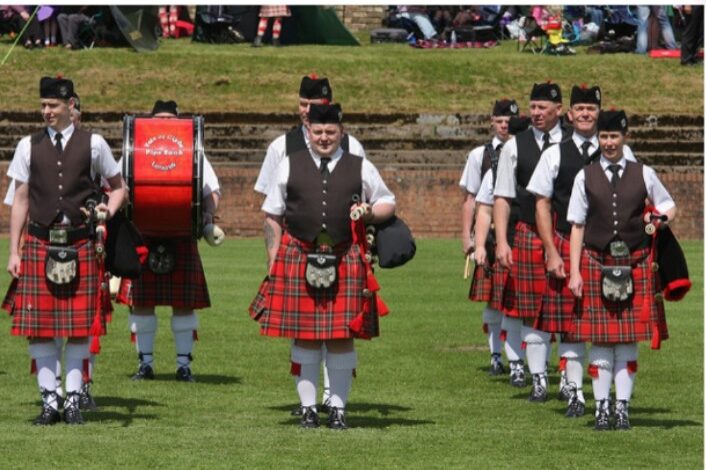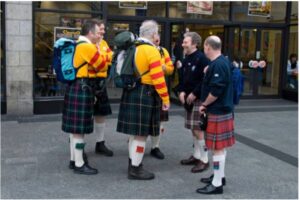Scottish Traditional Kilts Find Your Perfect Match in Classic Tartan

The traditional Scottish kilt is a powerful symbol of heritage, pride, and cultural identity, steeped in the rich history of the Scottish Highlands. Characterized by its distinctive pleats and iconic tartan patterns, the traditional Scottish kilt has evolved from a practical garment worn by Highland clansmen into a revered piece of ceremonial attire. Originally designed to provide warmth and protection against Scotland’s harsh climate, the kilt has become an enduring emblem of Scottish tradition. Whether you’re exploring your ancestry or simply drawn to its historical significance, choosing the perfect traditional Scottish kilt involves understanding its history, the meaning behind its tartan patterns, and the different styles available. This introduction will guide you through the essentials of selecting a kilt that honors this rich tradition while fitting your personal style. From classic tartans representing Scottish clans to modern adaptations, the traditional Scottish kilt continues to be a versatile and meaningful garment, inviting you to embrace a piece of history and wear it with pride.
The History of Kilts
The history of the kilt dates back to the late 16th century with the Feileadh Mór, or the Great Kilt, a large piece of woolen cloth that could be wrapped around the body in various ways. This versatile garment not only provided warmth and protection against Scotland’s unpredictable weather but also served as a blanket at night. Over time, the Great Kilt evolved into the smaller, more practical Feileadh Beag, or Little Kilt, which resembles the modern kilt we recognize today. This version, tailored and pleated, was easier to wear and became widely adopted by Highlanders for everyday activities.
The Significance of Tartan:
Tartan patterns, synonymous with Scottish kilts, are deeply rooted in the clan system. Each pattern, known as a “sett,” represents a specific clan, family, or region, making the kilt a powerful symbol of identity. Historically, clanspeople would use local plants, berries, and mosses to dye the wool, creating unique tartans that signified their lineage. Today, there are over 7,000 recorded tartans, with each one telling a story of its own. For those without Scottish ancestry, choosing a tartan can be as simple as selecting one that resonates with personal aesthetics or values.
Types of Kilts: Finding the Perfect Fit
When selecting a kilt, it’s essential to consider the occasion and your personal style. Here are some popular types of kilts and their uses:
- Tartan Kilt: The most iconic style, made from wool with distinct plaid patterns. Ideal for formal events, the tartan kilt is often paired with traditional accessories like a sporran, kilt pin, and sgian dubh (a small dagger). The alignment of the tartan pattern is crucial, reflecting respect for tradition and heritage.
- Utility Kilt: Designed for practicality, the utility kilt is perfect for outdoor activities such as hiking or working in rugged environments. Made from durable materials like ripstop cotton, these kilts feature multiple pockets and reinforced stitching, combining functionality with style .
- Casual Kilt: For those seeking comfort without the formality, casual kilts are a great option. Made from lightweight fabrics, they are suitable for everyday wear and can be styled with simple shirts or polo shirts for a relaxed look .
- Formal Kilt: Reserved for special occasions like weddings or gala dinners, formal kilts are made from high-quality wool and often feature intricate tartan patterns. They are typically worn with a tailored jacket, a bow tie, and other traditional accessories .
The Role of Kilts in Scottish Ceremonies & Events
Kilts hold a place of honor in Scottish culture, especially during ceremonies and events like weddings, Highland games, and Burns Night. Wearing a kilt during these occasions is a way to celebrate Scottish heritage and show respect for tradition. Each event may call for a specific type of kilt and accompanying attire, making it important to choose the right one based on the occasion. For instance, at a traditional Scottish wedding, the groom and his groomsmen often wear matching tartan kilts that represent their family’s lineage. Highland games participants might opt for sport kilts, which are designed to offer greater mobility and comfort during physical activities .
The Revival of the Kilt
The kilt has not always enjoyed the universal acceptance it has today. Following the Jacobite Rebellion, the British government introduced the Dress Act of 1746, which prohibited the wearing of Highland dress, including kilts. This was an attempt to suppress Highland culture and prevent further uprisings. However, the ban only strengthened the kilt’s symbolism as a badge of Scottish identity and resistance. After the ban was lifted in 1782, kilts experienced a resurgence, particularly during the Victorian era, when Queen Victoria and Prince Albert popularized tartan and Highland dress as symbols of Scottish pride.
Choosing Your Perfect Kilt
When selecting your perfect kilt, consider the following factors:
- Occasion: Determine whether the kilt is for formal, casual, or practical use.
- Material: Wool is traditional and provides warmth, while lighter fabrics like cotton are ideal for casual wear.
- Tartan Pattern: If you have Scottish ancestry, choose a clan tartan. Otherwise, select a pattern that appeals to you.
- Fit & Comfort: Ensure the kilt fits well at the waist and allows for comfortable movement.
- Accessories: Complement your kilt with traditional accessories like a sporran, kilt pin, and belt.
Fashion Kilt, a brand known for its wide selection of traditional and modern kilts, offers a variety of styles to suit every need. Whether you’re looking for a classic tartan kilt for a formal event or a utility kilt for outdoor adventures, Fashion Kilt provides high-quality options that cater to both traditionalists and contemporary fashion enthusiasts.
Custom Kilts USA With Your Unique Scottish Heritage
Custom kilts in the USA have gained immense popularity, offering a personalized way to connect with Scottish heritage or embrace the kilt as a unique fashion statement. With the rise of custom kilt options, enthusiasts can now choose everything from the tartan pattern and fabric type to specific details like buckle styles and embroidery, ensuring that their kilt is a true reflection of their individuality. Whether you have Scottish ancestry or simply appreciate the rich history behind kilts, customizing your garment allows you to create something truly special. In the Custom Kilts USA, brands like Fashion Kilt provide a range of customization services, making it easier than ever to craft a kilt that fits your exact preferences, whether for formal events, casual wear, or outdoor adventures. With a custom kilt, you can proudly wear a piece of tradition that’s uniquely yours.

The Global Appeal of Kilts
While kilts are deeply embedded in Scottish culture, their appeal extends far beyond the borders of Scotland. In the United States, for example, custom kilts have become increasingly popular, not only among those with Scottish heritage but also among individuals who appreciate the kilt’s unique blend of tradition and style. Brands like Fashion Kilt cater to this growing demand by offering a range of custom kilts that can be tailored to individual preferences, making it easier than ever to incorporate this iconic garment into your wardrobe.
Conclusion:
The Scottish kilt is more than just a piece of clothing—it’s a symbol of a rich cultural heritage that has stood the test of time. Whether you’re attending a formal event, participating in a Highland game, or simply exploring your Scottish roots, there’s a kilt that matches your style and needs. By understanding the history, types, and significance of kilts, you can make an informed choice that honors tradition while expressing your individuality. Explore the extensive collection at Fashion Kilt to find the perfect kilt for you. From traditional tartan patterns to modern utility designs, there’s a kilt for every occasion and every person. Embrace the tradition, and wear your kilt with pride.



